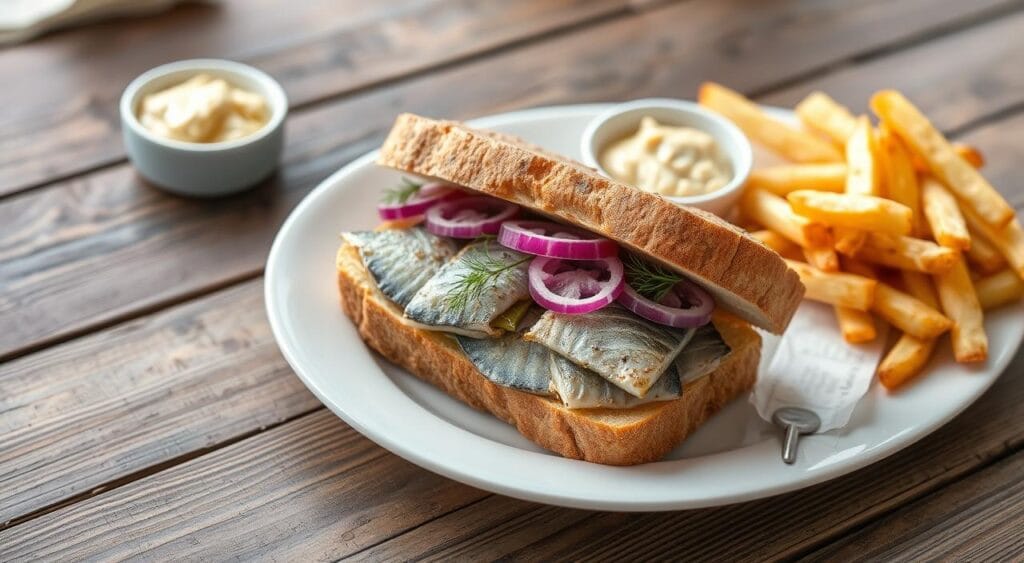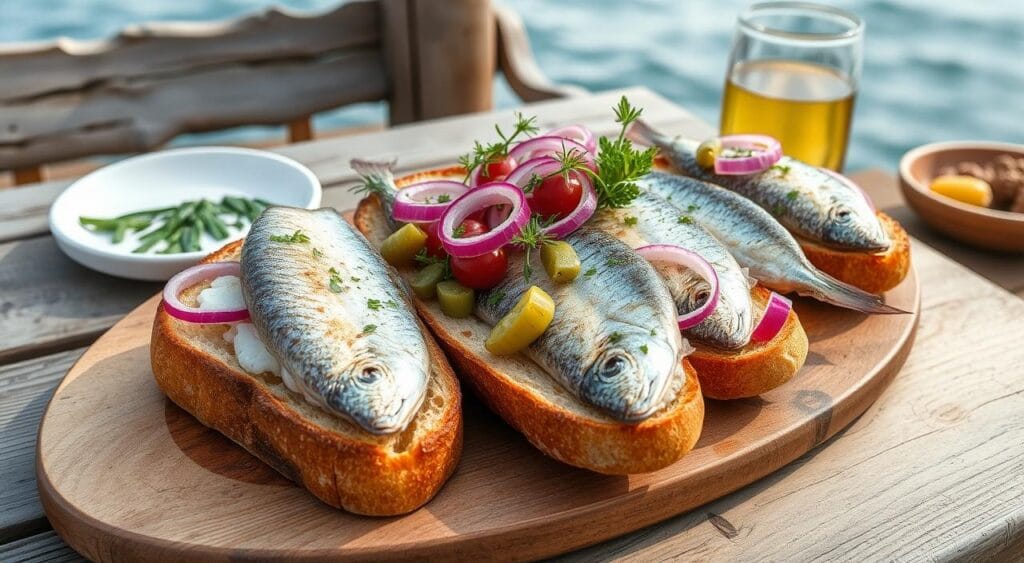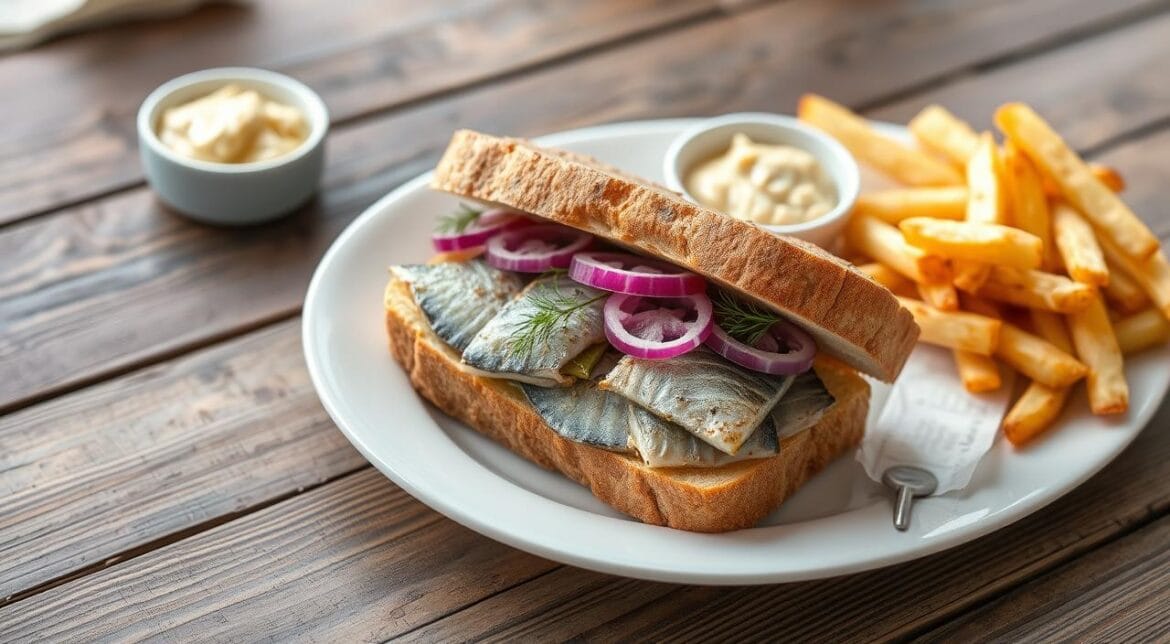Table of Contents
Explore the world of Matjesbrötchen, a favorite open-faced sandwich in Germany. It combines tender pickled herring, zesty remoulade sauce, and fluffy bread. This recipe is perfect for those who love German food or want to try something new.

Key Takeaways
- Matjesbrötchen is a classic German open-faced sandwich featuring soused herring, remoulade sauce, and bread
- The dish originates from Northern Germany and is a beloved regional specialty
- Properly selecting and preparing the herring is crucial for an authentic Matjesbrötchen experience
- Choosing the right bread, from pumpernickel to Kaiser rolls, can enhance the overall flavor profile
- Serving Matjesbrötchen with traditional accompaniments and toppings adds to the dish’s cultural significance
What Is Matjesbrötchen: Understanding the North Sea Delicacy
Matjesbrötchen is a beloved North Sea delicacy. It’s a traditional German sandwich loved for generations in coastal areas. This soused herring sandwich shows the rich culinary heritage and seafaring traditions of Northern Germany.
Origins of Matjesbrötchen in German Cuisine
The history of matjesbrötchen goes back to the 16th century. Back then, people perfected herring preservation along the North Sea shores. They turned simple herring into a prized delicacy through “souring” or “pickling.”
Cultural Significance in Northern Germany
Matjesbrötchen is more than a sandwich in Northern Germany. It symbolizes the region’s deep connection to the sea and its resources. Enjoying this North Sea delicacy celebrates the hard work and resilience of coastal communities.
Every step in making matjesbrötchen is filled with cultural meaning. It reminds us of the rich gastronomic heritage that shapes traditional German cuisine near the North Sea.

“Matjesbrötchen is more than just a sandwich – it’s a taste of the sea, a celebration of our coastal heritage, and a reminder of the enduring traditions that define our culinary identity.”
Essential Ingredients for the Perfect Matjesbrötchen Recipe
Making a true matjesbrötchen, the classic German fish sandwich, needs top-notch ingredients. The key ingredient is the pickled herring. It’s important to get the freshest, tastiest pickled herring for the best flavor and texture.
The remoulade sauce is also crucial. It adds a tangy, creamy touch that goes well with the fish. The bread, whether pumpernickel bread or a Kaiser roll, is also key. It’s the base for this tasty sandwich.
To make the perfect matjesbrötchen, you’ll need these ingredients:
- Fresh, high-quality pickled herring
- Homemade or store-bought remoulade sauce
- Pumpernickel bread or Kaiser rolls
- Crisp lettuce leaves (optional)
- Thinly sliced red onion (optional)
- Lemon wedges for serving (optional)
Using the best ingredients and mixing them with care will take you to Northern Germany’s coast. There, the matjesbrötchen is a beloved dish.
Selecting and Preparing the Soused Herring
Creating the perfect matjesbrötchen starts with the right soused herring. This seafood is key to the sandwich’s flavor. So, picking the right pickled herring and preparing it carefully is essential.
How to Choose Quality Pickled Herring
For a great matjesbrötchen, choose pickled herring that’s firm and shiny. It should have a nice, salty taste. This flavor should match the other sandwich ingredients well.
Preparing the Fish for Assembly
- Rinse the pickled herring fillets under cold water to remove any excess brine or pickling solution.
- Pat the fillets dry with a paper towel, being careful not to break the delicate flesh.
- Gently remove any small bones that may remain in the fillets, taking care not to tear the meat.
Traditional Curing Methods
The soused herring in matjesbrötchen is cured the old-fashioned way. This method includes salting, brining, and sometimes smoking. It preserves the fish and gives it a unique taste.
“The secret to an authentic matjesbrötchen lies in the quality of the pickled herring and the care taken in its preparation.”
By following these steps, you’ll make a delicious and true matjesbrötchen. It’s a seafood appetizer that shows off Germany’s coastal flavors.
Creating the Classic German Remoulade Sauce
Take your Matjesbrötchen to the next level with a traditional German remoulade sauce. This tangy, creamy sauce pairs perfectly with the rich pickled herring. It adds depth and complexity to your dish, making it a true traditional German cuisine delight.
To create the perfect remoulade sauce, you’ll need a few ingredients. You’ll need mayonnaise, Dijon mustard, lemon juice, capers, gherkins, and herbs and spices. The goal is to find the right mix of creamy, tangy, and savory flavors.
- In a medium bowl, mix 1 cup of mayonnaise, 2 tablespoons of Dijon mustard, and 2 tablespoons of fresh lemon juice. Whisk until smooth.
- Chop 2 tablespoons of capers and 2 tablespoons of diced gherkins. Add them to the mayonnaise mix.
- Add 1 teaspoon of dried dill, 1/2 teaspoon of ground paprika, and a pinch of salt and black pepper. Stir well.
- Taste and adjust the flavors. Add more lemon juice for tanginess or a bit of honey for sweetness.
For an authentic remoulade sauce, let the flavors blend for at least 30 minutes before serving. This allows the flavors to come together, creating a delicious sauce that will enhance your Matjesbrötchen.
The beauty of this sauce is its versatility. Feel free to try different herbs, spices, or even white wine vinegar to find your favorite flavor. Enjoy your Matjesbrötchen with this classic remoulade sauce and experience the true taste of traditional German cuisine.
Choosing the Right Bread: From Pumpernickel to Kaiser Rolls
Choosing the right bread is key to making a great matjesbrötchen. You want a bread that’s sturdy yet flavorful. It should hold up to the rich flavors of the herring and creamy remoulade. Let’s look at the best breads for your matjesbrötchen, from pumpernickel to Kaiser rolls.
Traditional Bread Options
In northern Germany, where matjesbrötchen comes from, certain breads are favorites. Pumpernickel bread is a classic choice. It’s dense, dark, and slightly sweet, with a nutty taste. Its robust texture is perfect with the delicate herring.
Kaiser rolls are also popular. They’re fluffy and slightly crisp. This makes them great for showing off the matjesbrötchen’s open-faced design.
| Bread Type | Flavor Profile | Texture |
|---|---|---|
| Pumpernickel | Slightly sweet, nutty | Dense, dark crumb |
| Kaiser Roll | Mild, slightly sweet | Fluffy, slightly crisp |
Storage and Freshness Tips
It’s important to keep your bread fresh and properly stored. For pumpernickel bread, use a paper or cloth bag at room temperature. Plastic can make it soggy. Kaiser rolls are best eaten the same day. Store them in a paper bag or bread box to prevent drying out.
By focusing on storage and freshness, you’ll make an open-faced sandwich that’s a delight. It will show off the bread and other matjesbrötchen ingredients beautifully.
Step-by-Step Matjesbrötchen Recipe
Making the perfect matjesbrötchen, or soused herring sandwich, is a fun journey. It celebrates the tastes of northern Germany. Follow these steps to make this classic dish at home and enjoy the real taste of the North Sea.
- Start by picking high-quality matjes, or soused herring. Make sure the fish is fresh, gently pickled, and tastes slightly sweet.
- Prepare the herring by rinsing it gently and drying it. Cut the fillets into thin pieces, making sure to remove any bones.
- In a small bowl, mix the sliced herring with a good amount of traditional German remoulade sauce. Mix until the fish is well coated.
- Choose your favorite bread, like a soft kaiser roll or pumpernickel. Slice it in half horizontally. Toast the bread lightly for a nice crunch.
- Spread the remoulade-coated herring mixture on the bottom half of the bread. Add thinly sliced red onion, crisp lettuce, and fresh dill if you like.
- Place the top half of the bread on the sandwich, pressing gently to hold everything together.
Your homemade matjesbrötchen is now ready to enjoy. The mix of savory herring, tangy remoulade, and soft bread is a treat. This classic German sandwich is a great way to taste the North Sea’s flavors.
| Ingredient | Quantity |
|---|---|
| Soused Herring (Matjes) | 4-6 fillets |
| Remoulade Sauce | 2-3 tablespoons |
| Kaiser Rolls or Pumpernickel Bread | 2 rolls |
| Red Onion | 1/2, thinly sliced |
| Lettuce | 2-3 leaves |
| Fresh Dill (optional) | 2-3 sprigs |
Authentic Garnishes and Toppings
The classic German North Sea delicacy of matjesbrötchen is all about the garnishes and toppings. These add to the flavor and give it a regional flair. They make this seafood appetizer even more special.
Traditional Accompaniments
In the traditional matjesbrötchen recipe, pickled herring is paired with classic garnishes:
- Finely chopped red onion adds a crunchy texture and sharp flavor.
- Fresh dill sprigs bring a vibrant, herbal note to balance the fish.
- Cornichons, or small French pickles, offer a tangy, crunchy contrast.
- A dollop of creamy remoulade sauce, made with mayonnaise, mustard, and herbs, adds creaminess.
Modern Variations
Modern takes on matjesbrötchen introduce new toppings:
- Sliced radish adds a peppery crunch and looks great.
- Microgreens or sprouts add a delicate, nutrient-rich touch.
- Capers bring a briny, tangy burst of flavor.
- Crumbled hard-boiled egg adds a creamy, protein-packed element.
Whether you choose traditional or modern toppings, they can make a big difference. The garnishes you pick can truly elevate the North Sea delicacy that is matjesbrötchen.
Serving Suggestions and Presentation Tips
When serving the classic German open-faced sandwich, known as matjesbrötchen, presentation matters a lot. These traditional open-faced sandwiches need a thoughtful and appealing way to show off their flavors and textures.
Start by picking the right serving platter or plate. It should match the rustic charm of the matjesbrötchen. A simple wooden board or a ceramic dish with clean lines works well. Arrange the open-faced sandwiches in a way that lets each one stand out.
| Serving Suggestions | Presentation Tips |
|---|---|
| Serve as an appetizer or light main course Accompany with a side salad or coleslaw Pair with a crisp white wine or a light beer | Arrange sandwiches on a wooden board or ceramic dish Garnish with fresh dill, lemon wedges, or micro-greens Drizzle the remoulade sauce artfully over the sandwiches |
To make the matjesbrötchen look even better, add fresh dill, lemon wedges, or micro-greens. A drizzle of authentic German remoulade sauce can also add elegance.
Serving these open-faced sandwiches as an appetizer or main course can make the traditional German cuisine experience better. With the right presentation and details, your matjesbrötchen will be the highlight of the meal.
Conclusion
In this article, you’ve learned about the rich history of matjesbrötchen, a beloved German dish. You now know how to make this North Sea delicacy in your kitchen. This includes the origins, essential ingredients, and step-by-step instructions.
To make a delicious matjesbrötchen, choose the best soused herring and remoulade sauce. Pair it with the right bread. This way, you can enjoy the flavors that have delighted Germans for generations.
As you start making matjesbrötchen, feel free to try new things. You can use different breads like pumpernickel or kaiser rolls. This lets you make the dish your own. Let the matjesbrötchen become a favorite in your home, embracing Germany’s rich culinary heritage.
FAQ
What is Matjesbrötchen?
Matjesbrötchen is a German fish sandwich. It has pickled herring, remoulade sauce, and toppings on open-faced bread. It’s a North Sea delicacy and a key part of German cuisine, especially near the coast.
What are the origins of Matjesbrötchen?
Matjesbrötchen comes from Northern Germany. The North Sea fishing has shaped the local culture for centuries. This dish celebrates the region’s pickled herring and is a cherished tradition.
What are the essential ingredients for an authentic Matjesbrötchen?
For a real Matjesbrötchen, you need pickled herring, creamy remoulade sauce, and sturdy bread like pumpernickel or Kaiser rolls. The quality of these ingredients is key for the best taste.
How do I choose and prepare the pickled herring for Matjesbrötchen?
Choose firm, flavorful pickled herring cured traditionally. Rinse and dry the fillets before making the sandwich. You can also try different curing methods to find your favorite taste.
How do I make the traditional German remoulade sauce?
To make German remoulade sauce, mix mayonnaise, Dijon mustard, lemon juice, capers, and herbs and spices. The goal is a creamy, tangy sauce that complements the herring.
What type of bread is best for Matjesbrötchen?
Pumpernickel and Kaiser rolls are the best breads for Matjesbrötchen. They’re sturdy and flavorful, holding up to the toppings. Keep the bread fresh by storing it properly.
How do I assemble the perfect Matjesbrötchen?
Start with bread, then add pickled herring, remoulade sauce, and toppings. Aim for a balance of flavors and textures for a great sandwich.
What are some traditional garnishes and toppings for Matjesbrötchen?
Traditional toppings include sliced onions, capers, hard-boiled egg, dill, and parsley. You can also try cucumber, radish, or horseradish cream for a twist.
How should I serve and present Matjesbrötchen?
Serve Matjesbrötchen as an appetizer or light meal. Arrange them neatly on a platter or plate. Pair with white wine, beer, or a side salad for a full German dining experience.


1 comment
[…] Posts Authentic Matjesbrötchen Recipe: How to Make the Classic… Step-by-Step Matjesbrötchen Recipe: Traditional and Modern Variations Explained Churu chicken […]
Comments are closed.